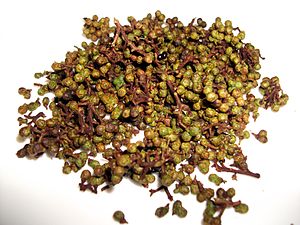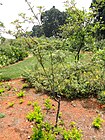Note: This is a project under development. The articles on this wiki are just being initiated and broadly incomplete. You can Help creating new pages.
Difference between revisions of "Zanthoxylum acanthopodium"
(Created page with "{{stub}} ==Uses== {{Uses|}}, {{Uses|}}, {{Uses|}}, {{Uses|}}, {{Uses|}}, {{Uses|}}, {{Uses|}}, {{Uses|}}, {{Uses|}}, {{Uses|}}, {{Uses|}}.<ref name="Uses"/> ==Parts Used== {{...") |
|||
| Line 1: | Line 1: | ||
| − | + | [[File:Andaliman.jpg|thumb|right]] | |
| + | Zanthoxylum acanthopodium is a prickly, evergreen plant that varies in habit from a shrub to a woody climber or a small tree. It can grow up to 6 metres tall. The plant is mainly gathered from the wild for its essential oil and medicinal use, though it is also sometimes cultivated. | ||
==Uses== | ==Uses== | ||
| − | {{Uses|}}, {{Uses|}}, {{Uses| | + | {{Uses|Dyspepsia}}, {{Uses|Fever}}, {{Uses|Cholera}}.<ref name="Uses"/> |
==Parts Used== | ==Parts Used== | ||
| − | {{Parts Used| | + | {{Parts Used|Seeds}}. |
==Chemical Composition== | ==Chemical Composition== | ||
| − | <ref name="chemical composition"/> | + | It contains the major compounds were linalool, 9,12-octadecadien-ol, 1,8-cineole , 2-undecanone, farnesol, 9,12,15-octadecatrien-1-ol and β-caryophyllene etc.<ref name="chemical composition"/> |
==Common names== | ==Common names== | ||
| Line 16: | Line 17: | ||
===Dravya=== | ===Dravya=== | ||
===Rasa=== | ===Rasa=== | ||
| − | |||
===Guna=== | ===Guna=== | ||
| Line 29: | Line 29: | ||
==Habit== | ==Habit== | ||
| − | {{Habit|}} | + | {{Habit|Evergreen tree}} |
==Identification== | ==Identification== | ||
| Line 48: | Line 48: | ||
==Mode of Propagation== | ==Mode of Propagation== | ||
| − | {{Propagation|}} | + | {{Propagation|Seeds}} |
==How to plant/cultivate== | ==How to plant/cultivate== | ||
| Line 54: | Line 54: | ||
==Commonly seen growing in areas== | ==Commonly seen growing in areas== | ||
| − | {{Commonly seen|}}, {{Commonly seen|}}, {{Commonly seen|}}, {{Commonly seen| | + | {{Commonly seen|Upland open forests}}, {{Commonly seen|}Thickets}, {{Commonly seen|Montane forest margins}}, {{Commonly seen|Rocky places}}. |
==Photo Gallery== | ==Photo Gallery== | ||
<gallery class="left" caption="" widths="140px" heights="140px"> | <gallery class="left" caption="" widths="140px" heights="140px"> | ||
| − | + | Andaliman is Batak Pepper.jpg | |
| + | Andaliman.jpg | ||
| + | Zanthoxylum acanthopodium var. timbor - Kunming Botanical Garden - DSC03185.JPG | ||
| + | Хималајски зантоксилум, Ботаничка башта Јевремовац, 01.JPG | ||
</gallery> | </gallery> | ||
| Line 64: | Line 67: | ||
<references> | <references> | ||
| − | <ref name="chemical composition">[ | + | <ref name="chemical composition">[https://www.researchgate.net/publication/233796294_Terpenoid_Constituents_of_Zanthoxylum_acanthopodium_DC_Leaves#:~:text=The%20chemical%20composition%20of%20the%20essential%20oil%20of%20Zanthoxylum%20acanthopodium%20DC.&text=The%20major%20compounds%20were%20linalool,%CE%B2%2Dcaryophyllene%20(3.0%25). Chemical constituents]</ref> |
| − | <ref name="Leaf">[ | + | <ref name="Leaf">[Morphology]</ref> |
| − | <ref name="How to plant/cultivate">[ | + | <ref name="How to plant/cultivate">[http://tropical.theferns.info/viewtropical.php?id=Zanthoxylum+acanthopodium Cultivation]</ref> |
<ref name="Uses">Indian Medicinal Plants by C.P.Khare</ref> | <ref name="Uses">Indian Medicinal Plants by C.P.Khare</ref> | ||
</references> | </references> | ||
==External Links== | ==External Links== | ||
| − | * [ ] | + | * [https://juniperpublishers.com/jcmah/pdf/JCMAH.MS.ID.555554.pdf Zanthoxylum acanthopodium on juniperpublishers.com] |
| − | * [ ] | + | * [https://indiabiodiversity.org/species/show/280529 Zanthoxylum acanthopodium on indiabiodiversity.org] |
| − | + | ||
[[Category:Herbs]] | [[Category:Herbs]] | ||
Revision as of 15:50, 8 September 2020
Zanthoxylum acanthopodium is a prickly, evergreen plant that varies in habit from a shrub to a woody climber or a small tree. It can grow up to 6 metres tall. The plant is mainly gathered from the wild for its essential oil and medicinal use, though it is also sometimes cultivated.
Contents
- 1 Uses
- 2 Parts Used
- 3 Chemical Composition
- 4 Common names
- 5 Properties
- 6 Habit
- 7 Identification
- 8 List of Ayurvedic medicine in which the herb is used
- 9 Where to get the saplings
- 10 Mode of Propagation
- 11 How to plant/cultivate
- 12 Commonly seen growing in areas
- 13 Photo Gallery
- 14 References
- 15 External Links
Uses
Parts Used
Chemical Composition
It contains the major compounds were linalool, 9,12-octadecadien-ol, 1,8-cineole , 2-undecanone, farnesol, 9,12,15-octadecatrien-1-ol and β-caryophyllene etc.[2]
Common names
| Language | Common name |
|---|---|
| Kannada | |
| Hindi | |
| Malayalam | |
| Tamil | |
| Telugu | |
| Marathi | |
| Gujarathi | |
| Punjabi | |
| Kashmiri | |
| Sanskrit | |
| English |
Properties
Reference: Dravya - Substance, Rasa - Taste, Guna - Qualities, Veerya - Potency, Vipaka - Post-digesion effect, Karma - Pharmacological activity, Prabhava - Therepeutics.
Dravya
Rasa
Guna
Veerya
Vipaka
Karma
Prabhava
Habit
Identification
Leaf
| Kind | Shape | Feature |
|---|---|---|
Flower
| Type | Size | Color and composition | Stamen | More information |
|---|---|---|---|---|
| {{{5}}} |
Fruit
| Type | Size | Mass | Appearance | Seeds | More information |
|---|---|---|---|---|---|
Other features
List of Ayurvedic medicine in which the herb is used
Where to get the saplings
Mode of Propagation
How to plant/cultivate
Commonly seen growing in areas
Upland open forests, {{Commonly seen|}Thickets}, Montane forest margins, Rocky places.
Photo Gallery
References
- ↑ Indian Medicinal Plants by C.P.Khare
- ↑ Chemical constituents
- ↑ [Morphology]
- ↑ Cultivation
External Links
- Ayurvedic Herbs known to be helpful to treat Dyspepsia
- Ayurvedic Herbs known to be helpful to treat Fever
- Ayurvedic Herbs known to be helpful to treat Cholera
- Herbs with Seeds used in medicine
- Habit - Evergreen tree
- Index of Plants which can be propagated by Seeds
- Herbs that are commonly seen in the region of Upland open forests
- Herbs that are commonly seen in the region of Montane forest margins
- Herbs that are commonly seen in the region of Rocky places
- Herbs




